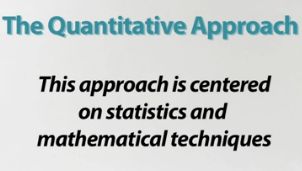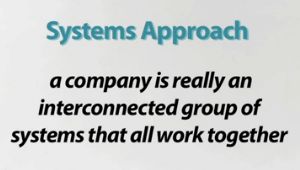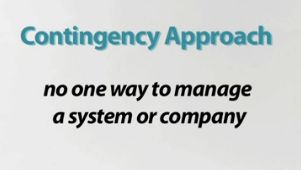Modern Theory of Management
After you watch the video and know the material, click HERE for the quiz.
Modern management theory has changed the way managers look at their jobs. Advancements and refinements in management theory and practice have enabled managers and managerial systems to evolve. In this lesson, we will look at modern management theories.
'Manage' Is an Adjective
Throughout history, there have been managers. Well, the reality is that way back in the day they were called 'leaders' or 'adventurers,' but as time went on the term 'manager' began to take hold. No one would ever think Christopher Columbus 'managed' his way to the Americas or that George Washington 'managed' the U.S. army. In many cases, these guys knew what they wanted to do or knew what they had to do and did it. Even today, we typically do not talk about managers per se but rather leaders. 'Manager' has become more of an adjective than a noun, describing what someone does or their role. 'Bill manages the department'; 'she's a great manager'; 'he managed the team very well', etc.
 |
What we have to understand is that a leader does indeed manage what they are responsible for. And, over time, there have been multiple theories of management that have evolved and that these leaders use as a guiding force behind their management or leadership philosophy. The three most recognized management theories are:
- The Quantitative Approach: This approach is centered on statistics and mathematical techniques - sounds like a boatload of fun if you ask me.
- The Systems Approach: As one could probably guess, this approach focuses on systems that, when put together, make a whole unit, kind of like a jigsaw puzzle.
- The Contingency Approach: This approach believes there is no one system or approach to managing an organization. These guys believe you take it as it comes but plan to deal with issues if they pop up. Anyone who has ever had a baby knows moms and dads have contingency plans all over the place just in case junior gets sick, is hungry or needs a nap.
So in this lesson let's take a look at these different theories and how they shape how leaders (okay, managers) manage these areas or companies they are responsible for. It's important to understand, though, that in one company, all these different approaches can be used. There's not one that is better than another, just different, and sometimes they have to be blended together for a company or organization to run.
 |
Quantitative Approach
Okay, get out your slide rules and calculators, because that is what this approach uses as its guiding principles. You see, the quantitative approach is solely reliant on statistics and data. The big word we are looking for here is quantitative, which means the measurement of quantity or amount. So a bunch of really smart people get together and they crunch and crunch data to decide how a business should run or be managed. Scientists use this approach a great deal and, in many cases, so do accountants and finance people, mainly because their world revolves around data. It is not glamorous or creative. Heck, it could even be said it isn't fun, but someone has to do it, and each part of a company or organization needs people to use this approach.
Think about if you had a manufacturing company that made flying monkeys. Well, someone has to statistically look at the data to make sure the monkeys are flying as far as they should and monitor if you are producing any defective monkeys (and no one wants a defective monkey). This data, once it's gathered, is presented to the company for review and action if needed.
Systems Approach
Now let's talk a little about the systems approach. When I was younger, I used to play with Legos - those little building blocks that I could make a house or car out of (okay, I thought it looked like a house or a car, but it probably looked more like a squid that was in a train wreck). In many ways, the systems approach to management is very much like Legos. The systems approach takes the viewpoint that a company is really an interconnected group of systems that all work together (or should work together). The best way to view this system is by thinking of a company as a machine. You have:
- Inputs: Material, information or data that goes into the machine
- Processes: Work that is done to the material, information or data while it's in the machine
- Outputs: The final product that comes out of the machine
 |
Okay, so in this system, managers see the company as one big machine that has to work together to take inputs and make them outputs. As an example, let's look at a toaster. The systems approach to management believes you put in bread, turn on the toaster and, when the process is done, toast comes out, hopefully not burned too much. Their job or belief is to work with each part of the system to make sure the end result is what is needed - what went in, what happened while it was in there and what it looked like when it came out.
To compare this to the quantitative approach, a manager that follows that approach would only want to know data about how long the bread was in the toaster and the level of, well, toasting that happened when it came out.
So we can begin to see how, in some companies, we have a blending of approaches to managing the work or organization. One wants to keep and track data to see how the company is functioning, and in many cases, that data can be presented to the manager that follows the systems approach to make changes needed if things are not running right in the process.
Contingency Approach
All this planning and thought is great, but you know what, stuff happens - systems break down, parts are not correct, people call in sick and buildings slide into the ocean. Thus, it is the contingency approach to management that takes this viewpoint into account by believing there is no one set way to manage a company. In a nutshell, these are the people that believe the car will run, and we'll get to the destination, but we'll always have a spare tire, lug wrench and cell phone in case what is supposed to happen (the car getting to where it is supposed to go) does not happen.
 |
Individuals that follow this approach believe there is no one way to manage a system or company. For these individuals, all the facets of management (planning, leading, organizing, controlling) are different for every circumstance, very much like men's clothing stores that sell suits. Every suit has to be tailored to the person buying it - some are short, thin, tall, plus-sized, whatever, and you have to address each circumstance as it comes at you. Sure, you can speak with the person that believes in the quantitative approach to get statistics on how many tall people come into your store each day, and you can talk to the person that believes in the systems approach and have a process to handle all the different material coming in so you can make the suits fast, but the contingency approach deals with the simple fact that you do not know what the day will bring.
You could have data that says 100 tall men will come into the stores each week, but that does not tell you who will come in that day. Similarly, the systems approach can be in place to take that same data and make sure you are ready to produce tall suits as quickly as you can. However, with the contingency approach, we will sit there and say we do not know what is really going to happen, so we have to be prepared to shift gears and react if needed. These are the people that are ready for a day of 25 plus-sized people and 50 short people when everyone else was geared up for a parade of basketball players to come in.
 |
Lesson Summary
So as you see, each of these approaches to management can stand on its own, but it is best to have them all working together, as every company needs them to be present. When we look at a football team, you could indeed put a team on the field of all quarterbacks, but that is probably not the best team to put out there. No, instead you use lineman, running backs, wide receivers, etc. to build a complete team. The same is true for blending these different types of approaches.
- The Quantitative Approach: The approach is centered on statistics and mathematical techniques.
- The Systems Approach: This approach focused on systems that, when put together, make a whole unit.
- The Contingency Approach: The approach that believes there is no one system or approach to manage an organization.
Now hopefully you can see that a company needs finance and data analysis people (quantitative approach), process and system people (systems approach) and contingency people (contingency approach) to truly be a well-rounded organization ready for just about anything. There has to be someone analyzing the data so the systems people can make adjustments while the contingency people are prepared in case something goes wrong with the process.